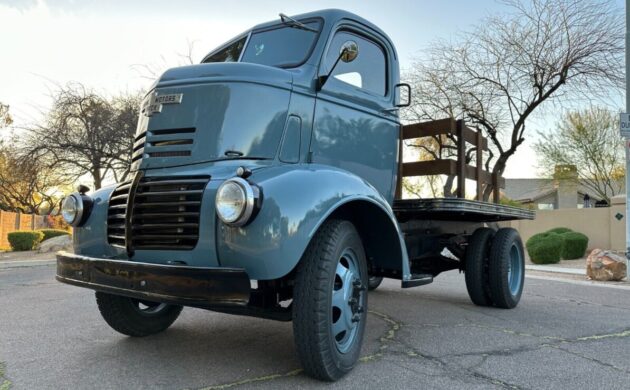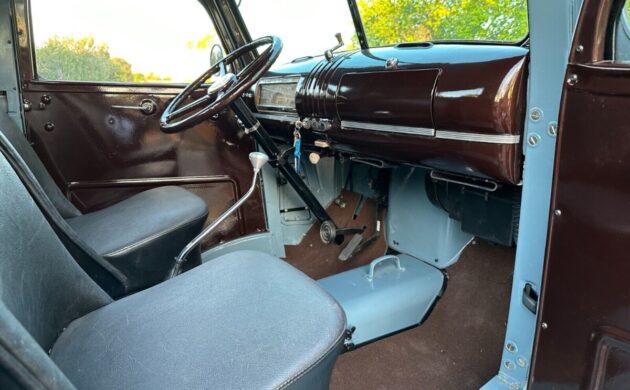The cab-over-engine (COE) truck began as an “engine under seat” design, produced by Autocar in about 1899. Early trucks didn’t even have cabs – though users sometimes built their own crude enclosures – until the late teens, when the driver gained partial weather protection. By the late 1920s, trucks finally offered fully enclosed cabs. When the 1930s rolled around, states were regulating weight limits for trucks to protect fragile roads. The cab-over design offered modest weight efficiencies since the shorter frame allowed for a longer bed with more room for freight. Too, the COE was blessed with better maneuverability over crummy roads. Rail congestion spurred the development of trucking as an industry and by the 1940s nearly every automaker also offered a truck, many of them cab-overs. Here on eBay is a 1941 GMC COE dressed in “farm truck” style, with an asking price of $38,000. This truck lives in Tempe, Arizona, and the tip is courtesy of T.J. – thanks!
During this truck’s restoration, the owner installed a modern Atlas aluminum 4.2-liter straight six-cylinder engine paired with a GM 4L60 automatic transmission and an aluminum radiator. The original six-cylinder motor is included, along with other original ancillaries. The new power drum brake system is still not perfect, requiring a double pump to attain pressure; the seller points to a possibly flawed master cylinder. With a truck this nice, the buyer has to have something to do!
The truck’s underside is a thing of beauty – it’s shown off in more than one photo in the listing. I cringe to think what this frame-off restoration cost, though the seller says the paint is “nice but not perfect”. The truck rides on new tires and tubes. The bed and stake sides look terrific – all it needs are a few bales of hay.
The interior retains its vintage appearance but the truck has been updated with air conditioning and robust heat. The seller notes that many of the hinges, latches, and glass panes are new. The seller is letting the vehicle go because his garages are full – the lucky buyer is going to get a rare vehicle. Early COEs are few and far between; the only one I was able to find was this 1941 Ford that sold for $66,000. This 1946 Chev COE, covered by our own Russ Dixon, was a no-sale at $31,800. The seller’s asking price seems reasonable to me; what do you think?






Looks very nice. At least it didn’t have to sacrifice its original chassis to be dropped onto another (Yawn!!!) belly-button Cummins 5.9 powered chassis. Sorry but the 5.9 transplants are getting to be the SBC of the light truck world. This resto-mod was done very well, with the original lines kept. I sure wouldn’t kick it off my driveway. Of course if it had come my way I’d have kept the original GMC powerplant under the floorboards and maybe hung an SMV symbol on the back. I might add that these trucks are downright scary to drive/ride over 65; they just weren’t designed to travel that fast. Overall, I like what I see and I do realize that a lot of people want something more reliable powering their ride. But then, I remember seeing a 24Valve 5.9 Cummins under a 50s IH COE with a broken crankshaft 800 miles away from home. That owner wanted modern, more reliable too…
Price is probably less than reincarnating that GMC extended cab is going to cost. Certainly done right.
( whispering so as not to cause deletion), I think it’s a 1940. Images show conflicting styles for ’41, but ’40 had this grill, ’41 had bigger bars. To show the lack of interest in modern things, I didn’t even know what an “Atlas” engine is. I can’t condemn the restorer, it’s done up to the nines, just not sure why, I mean, what are you going to do with this? Drive around? I mean, while it’s reliability is improved, for what? The vehicle won’t be used for anything more than what the original engine did, and in that regard, I think it would be worth more original. Reason for selling? Garage full? Poor baby,,,
Wait,,,forget that poor baby thing,,,deletion worthy, ( breathing into paper bag), and the authors description of the cabover is accurate, but to be clear, it was White that is credited with the 1st for actual use in 1932 with IH close behind. Cabovers were miserable trucks, and I hated everyone I ever drove, but did what the boss told me to. When length laws were present, it’s true, the shorter the truck, the bigger the trailer. Not sure about the authors mentioning better maneuvering on crummy roads, just the opposite, I found. In city applications, they did turn sharper, but its overall shortcomings and the removal of overall length laws, doomed the cabover, and I say good riddance. TEN-FOUR!
Shhhh…….Be verwy verwy quiet
He was the funniest one, now those cartoons are considered racist.
Good looking truck, have absolutely no idea why I might want to own something like this and I don’t. But the plus is it’s a nice build too! Best of luck to the seller.
Thanks, geomechs and Howard for the interesting insights. They are the main reason why I visit this site. They are a nice break from, “Gee, if I just had some money or space, I would be all over this”, or, “put a SBC in it.”
So you like predictably negative comments? I like to hear something good about the hobby, not the endless negativity spewed by the usual suspect. But I agree I wouldn’t put a small block Chevy in it. I’d put a big block Chevy in it.
Go ahead, get mad
Another fake gearshift installed by someone scared of three pedals. Too bad the original power train was gutted–at least the original motor is included.
Atlas engine? I don’t recall Sears ever selling engines. Lol
It’s been many years since I worked for a GM dealership but as far as I know, the Atlas series of engines was inline, aluminum block 4, 5, and 6 cylinder engines that came out in Canyon, Colorado, and Envoy vehicles. I never heard anything derogatory about them other than the typical negative propaganda coming from the import dealers. I’ve seen lots of Envoys with 200K miles and counting. Personally, if I was to repower a truck like this I would’ve picked something like a 261 or a 292, something that didn’t require computers and sensors and Tech II analyzers, and computer science degrees, and overall, lots of money to make the overall project start…
These COEs always scare me (especially after watching the horror flick “Jeepers Creepers”). If I was ever to look in my rearview mirror and see one, I’d pull over and let it pass.
Geeezzz….$38k and the brakes don’t work? Just needs a master cylinder? Probably true but if so fix it. These rigs are very interesting to drive. Because you are over the front wheels, the turning experience is very different. Ever have a VW bus or a Ford Econoline / Chevy G10 of the 60’s? Same strange feeling that takes a bit of getting used to. :-) Terry J
I’m looking to buy a small farm so I have a reason to buy this beautiful truck!
GM Atlas 4.2 inline 6s are a great replacement for older Chevy inline 6s – 275 Hp and 275 ft-lb torque from about 1600 rpm on up. They were used with a full frame in 2002 to 2009 Envoys and Trailblazers, older Chevy or GMC bodies can drop right on the newer frame and to get modern power, AWD, suspension, brakes, AC, etc. with the retro body. And 1800 rpm at 65 mph.
Only problem is the engine sits further forward over the front wheels (photo shows the hole through the oil pan for the FWD) and radiator modifications are required.
Sorry, hit the wrong button
A really cool old COE flatbed but the first listing I’ve ever seen where there were more pics of the chassis than the engine. In fact, NO PICS of the said Atlas replacement engine! SMDH
not a true coe,snub nose,
Actually a “snub nose” was another term for a cabover. The late 30s thru late 50s cabovers had a short nose, and a short hood, for access to the front of the engine, and nothing more, most of the engine was under the cab, hence, the term cabover. You’re thinking of later cabovers, with tilt cabs for engine access, and granted, they were more of a “true ” COE, but nevertheless, the early ones were cataloged as COEs
Actually found 1937 GMC ad, where they advertise it as a COE. I thought it was a “catch all” term.
Y’s right, think 60’s Ford C series 750/900 trucks. And 40’s White trucks. Real cab overs. COE gets used so much now for snubs it’s a done deal.
And Kenworth, Peterbilt, International, Freightliner, Mack…..Everybody had a cabover. Or COE.
the other 2 were slammed way too much tho I like the ‘pick-up bed’ on the blk one.
Gunna wrk it or show it?
That’s my general Q B4 a start. Take the orig design/engineering and use as advantage (not stumbling block). Urban livery it’ll B then. Do the best U can and it IS a show vehicle…
The right guy can have a pretty big company sign on both sides of this one.
Ever seen one done asa panel van? Ck these asa a buss in 1930 city:
https://www.pinterest.com/pin/428616089544895214/
a close facsimile~
i would keep it GMC and put a 302 in it
Back in the 50is to upgrade a chev you would put a 270 jimmy in,much better engine than a chev
GMC 302? Huh?
302 engines were used extensively by GM during the war. The General also powered the Futurelinrs with 302 engines. A friend of mine has a hopped up one powering his ’59 GMC. Goes pretty well…
As it appears the original drum brakes are still in use, it is likely the original hydraulics are still in use. As it takes 2 pumps to achieve a hard pedal, the brake problem is probably related to the following:
1. Brake shoes not adjusted closer to the drums. {Yes it could be as simple as adjusting the shoes.]
2. If it has the typical Bendix Hydrovac power brake unit, it may not have been bled. The Hydrovac is basically a second master cylinder, and many mechanics used to working on more modern trucks and not familiar with the unit, don’t realize it must also be bled. As can be in the attached diagram, the Master cylinder only provides pressure to the Hydrovac unit, and the unit then sends out fluid to the wheels.
3. The master cylinder may have a cylinder bore that is too small. If so, each pump of the master cylinder does not send sufficient quantities of brake fluid.
4. Check the play of the linkage into the master cylinder. This linkage may have too much play, thereby not providing a long enough stroke to the M/C piston.
5. Some linkages have several different holes to attach the M/C linkage to. Each hole will change the amount of piston travel.